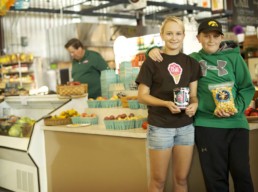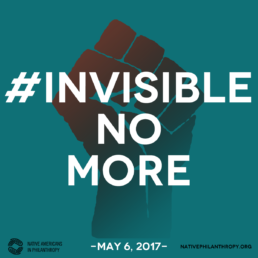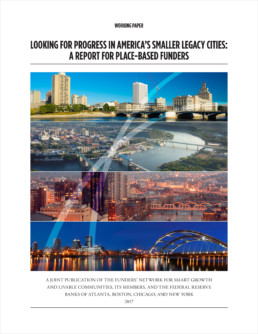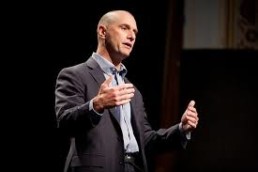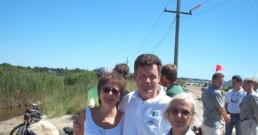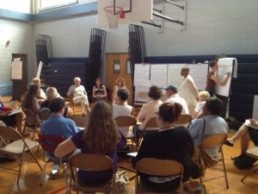Looking for Progress: How Cedar Rapids is Connecting Growth and Opportunity
As part of our ongoing work exploring the lessons and recommendations offered in Looking for Progress in America's Smaller Legacy Cities: A Report for Place-based Funders, we asked some of the participants in the study: How has revitalization proceeded in your community, and how might your foundation and local partners ensure that economic growth and economic opportunity develop in a coordinated fashion? Dr. Les Garner, Jr., president and CEO of the Greater Cedar Rapids Community Foundation, shares his thoughts:
The Looking for Progress report highlights the observation that revitalization in smaller legacy cities seems to move along two distinct paths: an “arc of growth,” traditionally seen as the purview of business, economic development commissions, and chambers of commerce, with the support of government; and an “arc of opportunity,” often seen as the responsibility of workforce development and K-12 educational systems, with the support of social service organizations.
In Cedar Rapids, we have recognized that revitalization must proceed in a way that ensures both economic growth and opportunity growth. Creative Corridor Rising, our current regional planning effort, is designed, in part, to bring the two arcs together.
The regional planning process has always included stakeholders invested in both the economic growth arc and the opportunity growth arc. Leadership of the process includes the business and economic development communities, higher education, our council of governments and the charitable sector as represented by the United Way of East Central Iowa and the Greater Cedar Rapids Community Foundation. Public education and area nonprofits have been at the table from the beginning.
The plan will address regional workforce development and issues of community development as well as regional economic development. The regional approach is critical in planning for the economic growth arc. As we consider those sectors that are most likely to experience rapid economic growth, we are searching for ways to merge intellectual capital from the University of Iowa with the manufacturing and production abilities of Cedar Rapids.
The arc of opportunity will certainly, but not exclusively, be addressed in the workforce development and community development sections of the plan. Issues under current discussion include removing barriers to workforce participation, enhancing affordable housing, and improving transportation. Issues related to early childhood and education achievement are being addressed, as are issues related to diversity and economic, social and cultural inclusion.
As a place-based funder, the Greater Cedar Rapids Community Foundation recognizes the important role that local nonprofits play in supporting both arcs. Many nonprofit organizations have adopted innovative approaches to addressing important components of the growth and opportunity arcs, including job training, family stability, affordable housing, health care, micro lending and the development of core neighborhoods. Along with other funders, we need to serve as a convener for conversations designed to pinpoint critical missing program elements and find the best way to use our limited resources and leverage private philanthropy to achieve a prosperous and equitable community.
A good example of the opportunities we will seek as the planning process proceeds is the work currently underway in the Wellington Heights neighborhood of Cedar Rapids. Wellington Heights is a core neighborhood that was, several years ago, considered to be at the “tipping point” of instability. Four Oaks, a family services agency, decided to focus energy on the neighborhood through its Total Child initiative. Total Child made the commitment to work with children from youth to adulthood and to support families through a variety of interventions, including making major investments in stabilizing housing in the neighborhood, an effort supported by other agencies including Habitat for Humanity. Jane Boyd Community House, an affiliate of Four Oaks, initiated the Paths Program to provide job training, coaching and advocacy for parents who faced barriers to entry into the workforce. It has subsequently partnered with corporate partner Go Daddy to establish a neighborhood-based entrepreneurial development program. The entrepreneurs who complete this program will find opportunities for financing through MICRO, the City’s micro lending program targeted to core neighborhoods. The Community Foundation convened the partners to establish MICRO, which is funded in part through private contributions. It has also funded Total Child and the Paths program. It will continue to seek such opportunities to help its nonprofit partners provide more comprehensive support for economic inclusion.
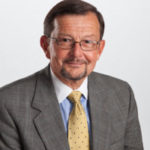 About the author: Dr. Les Garner, Jr., is president and & CEO of the Greater Cedar Rapids Community Foundation.
About the author: Dr. Les Garner, Jr., is president and & CEO of the Greater Cedar Rapids Community Foundation.
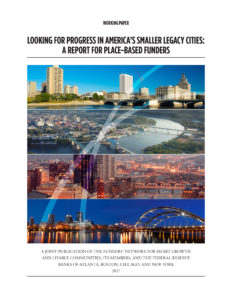 Looking for Progress in America's Smaller Legacy Cities: A Report for Place-based Funders
Looking for Progress in America's Smaller Legacy Cities: A Report for Place-based Funders
As part of The Funders’ Network-Federal Reserve Philanthropy Initiative, the Federal Reserve Banks of Atlanta, Boston, Chicago, and New York recently released, in partnership with The Funders’ Network, a whitepaper presenting findings from a four-city study tour of older, legacy cities. This blog is the second in an occasional series stemming from that report. The full report can be downloaded here.
Main photo credit: Iowa's Creative Corridor.
Invisible No More: Native Movement Building
Native Americans in Philanthropy (NAP) and more than 150 allies will gather in Los Angeles on May 6 for our Invisible No More: Native Movement Building summit and celebration. This event, held at the enigmatic L.A. cultural outpost The Underground Museum, will bring together national and global movements to discuss youth advocacy, narrative change strategies, and lessons from Standing Rock. We’ll also focus on best practices, and other major issues and innovations in Native American communities and across movements.
The issues and unique sovereign rights of Native Americans are often ignored or excluded, even in "woke" circles and spaces. The movement first sparked by Standing Rock has created a Ferguson-like moment for the Native American community.
NAP has been a consistent advocate for the protection of tribal sovereignty, land and water rights, and Native youth healing, by partnering with the Standing Rock Sioux Tribe and My Brother's Keeper, as well as building cross-movement advocacy efforts. NAP has also focused its work toward carrying on the Obama administration's legacy through Generation Indigenous (#GenIndigenous), an initiative first started by President Barack Obama in 2014. #GenIndigenous continues to encourage Native American youth to continue to draw on their Indigenous cultures, experiences and worldview as tools for social change.
Grounded by a "Movement of Movements" theme, this event on May 6 will shed light on the issues that affect us all, making them #InvisibleNoMore. Critical conversations will also highlight ways in which partners can collaborate and use social capital to support community-led solutions. Panels and breakout sessions will cover movement-building partnerships, youth advocacy, healing, mass incarceration, and more. This event will highlight our #GenIndigenous Regional Convenings amplifying work of non-profits serving native youth. (The next convening will be held in Seattle on April 28 with fall convenings scheduled for Southern California and Southwest regions.) The event will also support NAP’s #GenIndigenous Response Fund which provides grants to youth organizing groups responding to the current moment in ways that build long-term power for Native youth. Donations made to the fund will launch the first ever #GenIndigenous Virtual Giving Circle.
NAP believes there is no greater time for allies to add their voices to the movement than now, and is proud to join forces these allies to honor the spirituality, resiliency, voices, and priorities of Native Americans, especially in such a challenging socio-political environment:
- Dr. Bob Ross, president and chief executive officer for The California Endowment, established to address the health needs of Californians (and which is also a member of The Funders’ Network)
- Taboo of the Black Eyed Peas
- Twila True, founder of True Family Enterprises and the True Sioux Hope Foundation, which assists the people of the Pine Ridge Reservation by providing critical aid and support for the creation of a sustainable infrastructure
- Actress and activist America Ferrera
- Activists and philanthropists Max and Vicki Kennedy
- Ty Stiklorius, president and CEO of the entertainment firm Friends at Work, which supports culturally transformative artists and initiatives
- Ernie Stevens, Jr., chairman and national spokesperson for the National Indian Gaming Association (NIGA)
- Holly Cook Macarro, a partner in Spirit Rock Consulting and former director of the Office of Native American Affairs for the Democratic National Committee
If you are interested in learning more or attending this event, please contact NAP at events@nativephilanthropy.org.
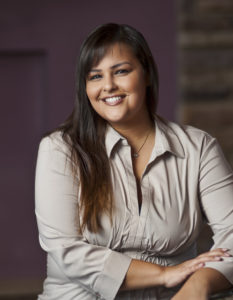 About the Author: Jennifer Fairbanks is a communications specialist for Native Americans in Philanthropy, a membership-based organization that promotes reciprocity and investment in, with and for Native peoples to build healthy and sustainable communities for all.
About the Author: Jennifer Fairbanks is a communications specialist for Native Americans in Philanthropy, a membership-based organization that promotes reciprocity and investment in, with and for Native peoples to build healthy and sustainable communities for all.
About this blog post: TFN is proud to celebrate and share stories and items of interest that are important to our funders and the broader philanthropic community. If you are interested in submitting an item to our blog, please contact TFN Communications Director Tere Figueras Negrete.
Looking for Progress in America's Smaller Legacy Cities: Takeaways & Tools for Place-based Funders
Place-based funders can play an important role in connecting economic growth to opportunity.
What began as an inquiry into four small legacy cities – Chattanooga, Tenn.; Cedar Rapids, Iowa; Rochester, N.Y.; and Grand Rapids, Mich. – that appeared to have experienced some measure of revitalization in the post Great Recession environment, evolved into an understanding that the places are moving along two distinct paths: an “arc of growth” and an “arc of opportunity.” In the context of these small legacy cities, growth and opportunity unfold simultaneously along these two long-term and distinct “arcs” leading to the conclusion that broad community prosperity lies in (1) recognizing that growth alone does not naturally lead to opportunity and (2) advancing deliberate policies, investments, and programs that connect growth to opportunity.
Looking for Progress in America's Smaller Legacy Cities: A Report for Place-based Funders looks at four cities and how place-based funders are helping in post-recession economic recovery. (Download the full publication here.)
Five Takeaways
Given the common narratives emerging from the study tour and the dual arcs framework for evaluating place-based revitalization, participants in the tour put forward a short, non-exhaustive, list of conclusions for funders:
1. Patient capital builds local capacity: The time horizons of community revitalization require capital that seeks both social impact and financial return over a longer-term. Place based funders are uniquely positioned to address the long time horizon that this work dictates, and the resources they control may be critical aspects in its acceleration or deceleration.
2. State policy often limits the flexibility and authority of local leaders to connect the arcs of growth and opportunity: Funders can take an active role in identifying those policy bottlenecks or opportunities that facilitate more positive local action toward connecting growth to opportunity. Place-based funders can be catalytic change agents for both policy and practice without engaging in lobbying.
3. Jurisdictional authorities dictate policy to connect the growth and opportunity arcs: The levers of power and resource allocations accorded to any number of public or pseudo-public authorities have a significant, often negative impact on the efficacy of efforts to connect the dual arcs. Funders can take an active role in helping to identify and break down or circumnavigate local jurisdictional boundaries that prevent positive action and facilitate alignment toward common goals.
4. Effective marketing and communication advances positive momentum: Maintaining a steady cadence on the long-term mission of community revitalization often falls to place-based leaders. In most cases, the community foundation or another place-rooted funder had a role in funding or otherwise supporting the narrative of a community’s recovery, articulating a common, inclusive vision of what is possible.
5. Accountability is the lynch pin for connecting the arcs: Cities around the country (including the four visited) have revitalized in various ways over the last several decades. But benefits of that growth have left many behind. Place-based funders should be strategic in holding local stakeholders accountable for connecting the growth and opportunity arcs.
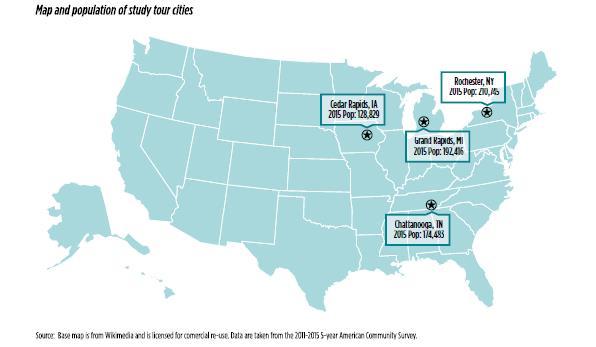
Helpful Tools
Despite the challenges of connecting the arcs, multiple tools or approaches in which the local place-based foundation played a lead role as a funder, convener or ‘steward’ of the effort that may be valuable to other communities were noted. These tools were observed within a local context, and were often part of a broadly articulated plan or vision. While tools are helpful, the environment in which they are most likely to succeed is also important.
• Addressing concentrated poverty by place: Interventions in this category were geographically targeted, but multi-faceted and cross-generational. Stressed communities that were located near resources – perhaps transportation or a good school – were seen as good places to start.
• Addressing concentrated poverty through policy: Interventions in this category were explicit in channeling more gains from growth to opportunity, through local policy either by removing barriers or being prescriptive in the intentional distribution of benefits.
• Revitalizing downtown with greater attention to preserving and increasing affordable housing: While investments in making communities more attractive by building downtown entertainment or “innovation” districts and increasing desirable amenities has increased property values and living costs, cities are facing the need for more affordable, family friendly housing options near emerging employment opportunities.
• Business recruitment led by business retention: Community economic growth strategies focused on strengthening existing businesses by recruiting businesses in their supply chain, placing retention and success of existing business as a higher priority than traditional recruitment alone. Coordinated workforce development was often key to this strategy.
• Develop leaders: Concern exists about where the next two generations of leaders will come from and how they will support broad-based collaborative efforts. Strong leaders in business, government and non-profits, are critical to building a regional approach to both arcs.
• Data collection: Data has played an important role in many of the cities visited. Data should be publicly available and granular enough to support neighborhood level understanding as well as robust enough to present an aggregated, comprehensive city – or MSA-wide -- profile.
Local dynamics dictate the timing, sequence, and particularities of the interplay between growth and opportunity strategies. Revitalization efforts that recognize the dual arcs and plan for their meaningful integration are more likely to yield robust and lasting long-term results. Because place-based funders are so integrally linked to the history and prospects of the communities they serve, they have unique roles and responsibilities not only as funders, but as local institutions and innovators to make these linkages across place and time.
About the Authors
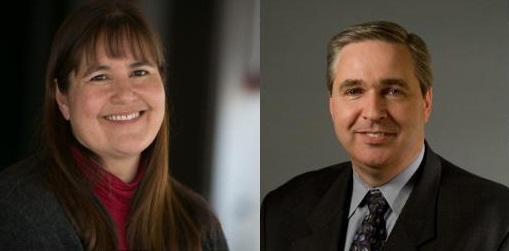
Alicia Kitsuse is Director of TFN's Older Industrial Cities Program.
Jeremiah P. Boyle is Managing Director of Community and Economic Development for the Federal Reserve Bank of Chicago
Looking for Progress in America's Smaller Legacy Cities: A Report for Place-based Funders
The Federal Reserve Banks of Atlanta, Boston, Chicago, and New York recently released, in partnership with The Funders’ Network, a whitepaper presenting findings from a four-city study tour of older, legacy cities.This blog is the first in an occasional series stemming from that report. Future installments will reflect the views of some of the place-based funders that collaborated with Federal Reserve staff in the study tour visits and the subsequent report. This initial blog features, as background, the executive summary of the report. The full report can be downloaded here.
2017 Annual Conference President's Message
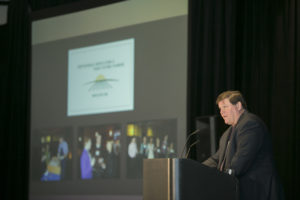 Hello, I’m Ben Starrett, president and CEO of the Funders’ Network.
Hello, I’m Ben Starrett, president and CEO of the Funders’ Network.
It’s great to see so many friends here. It’s especially great to see so many new friends who are joining us this year for the first time.
Let me begin by acknowledging the tremendous support for this year’s conference from our funders.
The leadership of our conference co-chairs and their designees also has been invaluable. I want to thank Phil Henderson and Shawn Escoffrey from Surdna, Kate Wolford and Eric Muschler of McKnight, and Eric Jolly and Carrie Jo Short of the Saint Paul Foundation — and all of our other sponsors. We simply couldn’t have done this without your help.
TFN’s annual conference is our most important member service. This conference also gives us a chance to highlight your amazing work.
Hosting a conference of this scale is truly a team effort. As always, the TFN team rose to the challenge. The team also includes the many volunteers who helped design conference sessions, shared their wisdom, and will lead our mobile workshops.
One of the hallmarks of a TFN conference is the opportunity to learn from place. Here are a few of the many ways we’re learning from place in the Twin Cities:
• If you were lucky enough to get a spot on our pre-conference tour on Sunday — which was filled to max! — you learned how artists are leading equitable development in their neighborhoods.
• Later today, you’ll have a chance to explore more of the Twin Cities thanks to our six mobile workshops.
• And later this evening I hope to see everyone at our very popular EAT Here! Reception. It will be a great evening. I want to thank the team at the Sustainable Agriculture and Food Systems Funders for their 15 years of support for our EAT Here! Reception.
This is the first TFN Annual Conference since the presidential election. I want to take this opportunity to reaffirm our belief that now is the time for philanthropy to live up to its highest ideals and demand that our country creates inclusive and sustainable places to live and work for everyone. TFN is committed to nonpartisan but forward-looking approaches that advance sustainability, prosperity, resiliency, and equity and inclusion.
We designed this conference for you to engage with each other and leaders in philanthropy and other fields about the challenges and opportunities on the road ahead.
And we’ll end our conference with a closing plenary by a retired Marine who has helped craft a strategic narrative that places sustainability at the heart of our nation’s security and well being. And he’s the first Top Gun graduate we’ve ever had as a plenary speaker!
TFN is advancing sustainability, prosperity, and resiliency, in many ways. Here are just three examples:
• Our Partners for Places matching grants program has provided and leveraged more than eight million dollars in communities across North America to support innovative sustainability projects.
• Our Older Industrial Cities and Anchor Institutions programs are working toward prosperity in places where we know there is untapped potential and tremendous opportunity for inclusive economic development.
• Our Philanthropic Preparedness, Resiliency, and Emergency Partnership — or PPREP for short — is connecting and supporting 17 community foundations across the Midwest. Many of our PPREP participants are here with us today!
Equity and inclusion are foundational values of TFN. They’re embedded throughout all of our work. Looking ahead, we are working on a learning curriculum for funders on structural racism and inequality. Stay tuned in May for more information on this new 18-month learning series.
And I’m very proud that TFN’s staff and board are an incredibly diverse group of individuals who truly represent the many faces of America.
One of the programs we are most proud of is our PLACES fellowship, a year-long experience that gives leaders in philanthropy the tools they need to ensure the values of inclusion and equity are reflected in the work they do. We already have nearly 100 PLACES alumni who have gone through this fellowship. This year, we had a record number of applications for our 2017 cohort. You’ll meet many of our new PLACES fellows — and many PLACES alumni — at the conference.
We all know that there are no easy answers when we are looking at problems that stem from structural racism and inequality, which include obstacles to education, healthcare, affordable housing, economic prosperity, and opportunity in its many forms. But those difficult answers only come if we are willing to ask ourselves difficult questions:
• Are we thinking creatively about how we can change systems?
• Are we breaking down silos and fostering collaboration?
• Are we working in ways that are interdisciplinary and intersectional?
• Are we demanding accountability and more equitable outcomes?
• And are we the best allies and advocates we can be?
I believe that if you’ve taken the time to attend this conference, the answer is a resounding YES!
All of us here at TFN are equally committed to this hard but important work. We are working to support collaboration within and across TFN’s working groups and we are working closely with our colleague affinity groups to leverage opportunities for positive change. We’ll continue to offer meaningful programming and networking opportunities that will position TFN as a true hub for learning and collaboration — bringing together national, regional and community funders, and other key players in philanthropy.
Because TFN is exactly that. A network where funders join together to strengthen relationships, forge new bonds, and increase their impact.
Remember, this is your network. The more you put into it, the more you will get back from it.
Thank you,
Ben Starrett, president and CEO, Funders' Network
Annual Conference Spotlight: A Former Marine Turned Sustainability Crusader
As a tough-talking Marine who trained as a fighter pilot and has done a stint inside the Pentagon, Col. Mark "Puck" Mykleby might seem like an unlikely ally in the battle over environmental stewardship and sustainable living.
But Mykleby is not just an ally. He’s an undaunted crusader and the co-author of The New Grand Strategy: Restoring America’s Prosperity, Security and Sustainability in the 21st Century. He frames sustainability not as a polarizing red versus blue issue, but a red, white and blue issue: a cornerstone of national prosperity and security that is essential to building a stronger, safer and more resilient America.
Mykleby, or “Puck”, as he prefers to be called, will be the Closing Plenary speaker at our TFN Annual Conference in Saint Paul, Minn., March 20-22. We talked to him about his passion for sustainability, his advice for funders navigating a divided post-election landscape — and the importance of being able to take a “gut punch” and still keep fighting (metaphorically speaking).
The book you co-authored stems directly from the work you did at the Pentagon, working to draft a national strategic narrative at the behest of Admiral Mike Mullen, then Chairman of the Joint Chiefs of Staff. At what point did you and your co-author realize sustainability was central to this work?
We asked, what’s going to give us the best shot of making it in the 21st Century? And that’s when we decided that the ecological concept of sustainability was our best shot at building our strength at home while at the same time building our credible influence abroad. In simple terms, we saw sustainability as the key to converging our domestic and foreign policies toward a larger global purpose, where our smart growth at home could become our smart power abroad.
You also talk a lot about resiliency. How does that tie in to security and sustainability?
I’ll use my Marine language: You need to be able to take a gut punch and come back swinging. You look at ecological systems and those that are monocultures wither and die. You have to bake resiliencey into your philosophical framework — and you’re going to be a helluva lot more effective dealing with climate change, resource scarcity and the reality that there are haves and have-nots in the world. You can’t have security without prosperity. And you can’t have prosperity without sustainability. Prosperity and security constitute an interdependent system that must remain in balance.
You can’t have one without the other. Sustainability provides a path to both prosperity and security. It’s not really about being green. It’s about the moral question of the human condition today and what it will be in the future.
You’re a former Marine, a Top Gun graduate, and a veteran of multiple deployments across the globe. Are people surprised that your career now focuses on advocating for things like sustainability, smart growth and environmental stewardship?
I guess some folks get somewhat taken aback. Some conservatives look at me as an idealistic sellout, to what, I don’t know. But I’ll put my military service record and experience up against their ideology any day. By the same token, a lot of liberals push back because of the pragmatic, business-led approach we advocate in the book. I guess you can say, for those of us who spent a life in military service, principled pragmatism trumps ideology.
As a veteran of D.C. who has worked in the Pentagon, what’s your advice to funders who worry about the current administration’s attitude toward important issues such as environmental protection?
If you’re in a fight, someone’s going to always throw an obstacle in your way. You go over it, you go around it. So go find a mayor, a city council member, to get things done at a municipal level if you need to. I don’t have all the answers. But I do know that the answer isn’t whining about it. Figure out where you’re going to have an impact. Figure it out!
You’re not just a speaker and an author, you’re also a dad to a teenage son. What kind of world do you hope he inherits?
In a misty-eyed kind of way, I want my son to have unlimited possibilities. I don’t want the actions of my generation to limit my son. I believe in and respect what this country stands for. We as citizens are compelled to act upon the Preamble of the Constitution, to “secure the blessings of liberty to ourselves and our posterity."
That means clean air, a clean environment, a resource-rich environment to live. This is such a beautiful place, and we should all be proud of this idea that is America. I refuse to believe that our greatest generation is in our past. I refuse to believe that. I do believe our country has so much more great to deliver. I really do.
Register here for our TFN Annual Conference in Saint Paul! Check out our conference highlights page on more information on panels, speakers and other news.
Photo: Kris Krüg for PopTech
Remembering David Burwell, Transportation Visionary
IN MEMORIAM: David G. Burwell 1947-2017
David Burwell served as policy advisor for TFN’s Transportation Reform Funders Group from 2009-2013.
We lost David Burwell on Feb. 1 to a three-year battle with cancer. He was 69 and, as many of you know, was a founder of Rails to Trails and later served as transportation advisor to TFN for several years.
I had the great good fortune of working side-by-side with David, leading TFN’s Transportation Reform Funders’ Group (TRFG) from 2009 to 2013. David was tireless, helping funders understand what was at stake on transportation issues and how to become engaged. He spent most of his life successfully demonstrating why transportation is like air: It affects everything.
David had a rare combination of qualities. On the one hand, he was playful and wry. On the other hand, the man was thorough and dogged. I seriously doubt he ever took a day in which he simply did nothing. He was a lawyer by training, with an attorney’s eye for deep detail. He was a teacher by instinct, able to put a human face on transportation issues -- starting with his contribution to the 1970s book, The End of the Road: A Citizen’s Guide to Transportation Problem-solving. Long before it was common to view transportation infrastructure as a divider of race and class, David explained what 1960s highway construction actually meant for people, communities and race relations. The Rails to Trails Conservancy, of which David was a co-founder, called him a visionary, noting the "the world lost a passionate conservationist and environmentalist."
His engaging style and passion hooked many a young advocate on transportation policy, including my husband, James Corless. I first met David in 2004 and I had good reason to dislike him from the outset. David flew from D.C. into Oakland, where James and I lived. The three of us went to dinner. He explained calmly and rationally that James, then a transportation advocate in California, was needed in Washington for a temporary policy gig. Could he please start the next week? I was aghast. James and I were engaged to be married (in California!) and all I could contemplate was that living apart was not part of my marital plans.
That evening, David did what David did best: He made me feel really good about doing the right thing for the cause, even if that meant sending my fiancé 3,000 miles east. Eventually, James returned, we were married, had kids and – voila! – four years later, David came calling again. At another dinner in Oakland, David again wanted to know: Would James move to D.C. again, this time for good? There was a new group called Transportation for America and James was needed …
Sprinkled by that fairy dust only David possessed, James and I said, “We’re in!”
The rest is history. I later had the privilege of working with David as advisors to TFN’s Transportation Reform Funders Group (TRFG), where his enthusiasm and deep knowledge helped many funders see how transportation affected the issues about which they cared.
I was looking through my emails recently to find some examples of David’s knack for writing about dense policy details with catchy, understandable language. To wit, some TRFG quotes from Mr. Burwell:
• “It was a very good piece of legislation, except it was mugged at the finish line.”
• Of another legal effort, he wrote: “Well, the best we can say about this bill is that the Wall Street Journal doesn't like it either – for a very good reason -- because it doesn’t explain where the money comes from…”
• And later, mindful, as ever, that proposed laws are only improved when shaped by outside voices, he wrote: “The best news is that the reform coalition and its 400+ partners were a real force to be reckoned with in this bill….”
I am sure that somewhere in the dictionary, under the phrase, “brilliant mensch,” there is a picture of David Burwell. There is a smile on his face, and in his hand is a book about transportation. From his lips spring funny, erudite words explaining why you, dear listener, ought to get involved in the transportation fight right now.
Ride the train in peace, dear David. We will miss you more than we can say.
Photo: David Burwell with his wife Irene and mother Barbara in 2002 | Courtesy Rails-to-Trails Conservancy
The Doctor Is In: Bolder Advocacy Offers Tips on Advocacy Work at TFN's Annual Conference
The Doctor Is In: Abby Levine, director of the Bolder Advocacy Initiative
Do you want to know more about how your foundation can support advocacy — or engage in advocacy itself?
Our 2017 Annual Conference in Saint Paul, Minn., March 20-22, will feature Abby Levine, director of the Bolder Advocacy Initiative at the Alliance for Justice as our “Doctor Is In” expert.
Abby will be available throughout the conference for free, one-on-one consultations to answer questions and share tools and resources about how private and public foundations can support grantees’ advocacy efforts. She’ll also offer guidance on how foundations can engage in advocacy themselves.
These are key strategies in the philanthropy toolbox. But we know there is a lot of confusion about what’s allowed and what’s effective. The Bolder Advocacy Initiative provides information, legal guidance, tools, and resources to help foundations understand the rules and maximize their resources. The Funders’ Network is pleased to feature their work as part of our continued commitment to helping funders navigate the road ahead with a forward-looking eye towards strategic approaches at the federal, state, regional, and local levels.
Abby will hold short, private consultations, available through sign-ups on-site in Saint Paul.
Register today for our TFN Annual Conference!
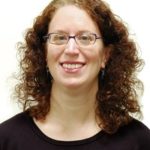 About Abby Levine
About Abby Levine
Abby Levine serves as director of the Bolder Advocacy Initiative at Alliance for Justice. She provides legal guidance that encourages grantmakers to support advocacy and other nonprofit organizations to participate in policymaking decisions through an understanding of federal tax and election law.
Abby’s work includes creating curriculum, teaching workshops, providing technical assistance, writing plain-language legal guides, and describing federal legislative and regulatory developments that impact nonprofits. Prior to joining Alliance for Justice in 2004, Abby served as the public policy analyst at the National Council of Nonprofit Associations and was an associate in the tax department at Squire, Sanders & Dempsey in Cleveland, Ohio. Abby holds a law degree from Case Western Reserve University School of Law and a bachelor’s degree from American University.
Saint Paul Spotlight: Philanthropy's Post-Election Gameplan
As a new administration takes the helm in Washington, how will philanthropy navigate the road ahead?
Join us for the Funders' Network Annual Conference in Saint Paul, Minn., March 20-22, 2017, for analysis and discussion of our post-election climate — and how funders can become even more engaged and effective.
Our annual conference offers several opportunities to learn from experts about philanthropy's role in the months and years to come:
The Road Ahead: Funder Perspectives on Opportunities and Challenges in 2017 and Beyond
Afternoon Plenary
4-5 p.m. Monday, March 20
The aftermath of the 2016 elections revealed a new political and social climate. Funders are examining ways to address opportunities and challenges at the federal, state, and local levels. This interactive panel of foundation leaders will engage in a lively discussion of new strategies and approaches as we grapple with a changing landscape and shifting roles for philanthropy.
Speakers
David Abbott, executive director, The George Gund Foundation
Phillip Henderson, president, Surdna Foundation
Kate Wolford, president, The McKnight Foundation
Moderator:
Scot Spencer, associate director of advocacy and influence, The Anne E. Casey Foundation
Moving Forward: Navigating the New Political Landscape
Tuesday Morning Plenary
9-9:45 a.m. Tuesday, March 21
Join us for a panel discussion providing post-election insight on issues such as equity, economic opportunity, and environmental stewardship.
Speakers:
Tamara Draut, vice president of policy and research, Demos
Brentin Mock, staff writer, CityLab
Moderator:
Phillip Henderson, president, Surdna Foundation
For nearly two decades — and multiple presidential administrations — TFN has served as both an ally to and resource for the philanthropic community. We hope you'll join us in Saint Paul as we discuss the post-election landscape and other topics of urgency to our network of funders.
Here are some resources and highlights to help you plan your trip:
▪ Conference Highlights
▪ Registration and Hotel Accomodations
How Can Philanthropy Help Disaster Relief and Recovery?
For the past two years, TFN and the Center for Disaster Philanthropy have been involved in an exciting regional effort to strengthen community foundations in their knowledge of disasters and to empower their leadership in this arena.
The Philanthropic Preparedness, Resiliency & Emergency Partnership (PPREP) program is directed at seventeen community foundations from a ten-state area in the Midwest, along the Missouri River. This year, PPREP welcomes additional community foundations from the area to the program, with the continuing support of the Margaret A. Cargill Foundation.
Kimberlee Maphis-Early, senior associate at the Center for Disaster Philanthropy, shares some of the practical resources PPREP provides in this CDP blog post.
Partners For Places Now Accepting Proposals For Spring 2017 Matching Grants Cycle!
We're currently accepting applications for the Spring 2017 cycle for Partners for Places, a competitive grant program that provides matching investments from national foundations to build partnerships between local government sustainability leaders and place-based foundations in the United States and Canada. Grants support sustainability projects that demonstrate broad-based community support and engagement.
In partnership with the Urban Sustainability Directors Network, the Funders' Network for Smart Growth and Livable Communities announced applications were open for Round Ten of Partners For Places on Dec. 5, 2016. The application deadline for Round Ten is January 30, 2017
What is sustainability? A sustainable community promotes a healthy environment, a strong economy and well-being for all residents, now and for future generations.
Through these projects focused on sustainibility, Partners for Places fosters long-term relationships that make our urban areas more prosperous, livable, and vibrant. The grant program provides partnership investments between $25,000 and $75,000 for one-year projects, or $50,000 and $150,000 for two-year projects, with a 1:1 match required by one or more local foundations.
Please visit the Partners for Places webpage for more information, including;
- Our PFP explanatory video
- Request for Proposals (RFP)
- Proposal Form
- Frequently Asked Questions (FAQ)
- Partners for Places Idea Bank, which has summaries of previous projects.
TFN will host a Partners for Places informational webinar to answer any questions about the grant program on December 7, at 3:00 p.m., Eastern Time. Please register for the webinar here. A recording of the webinar will be made available through TFN’s website for those of you unable to participate.
Partners for Places general grant program is supported by Bloomberg Philanthropies, The JPB Foundation, Kendeda Fund, New York Community Trust, The Summit Foundation, and Surdna Foundation. A selection committee comprised of foundation representatives and urban sustainability directors will make selection decisions on behalf of Partners for Places, and awards will be announced on May 3, 2017. If the RFP and FAQ documents don’t answer all your questions, please contact Ashley Quintana at ashley@www.fundersnetwork.org or Ann Wallace at ann@www.fundersnetwork.org for more information.

